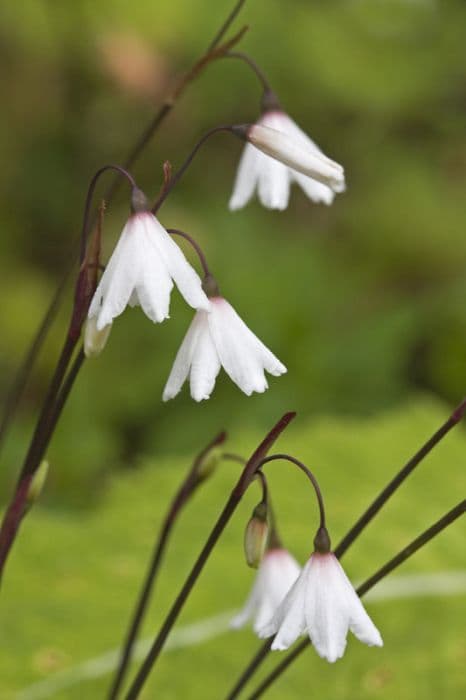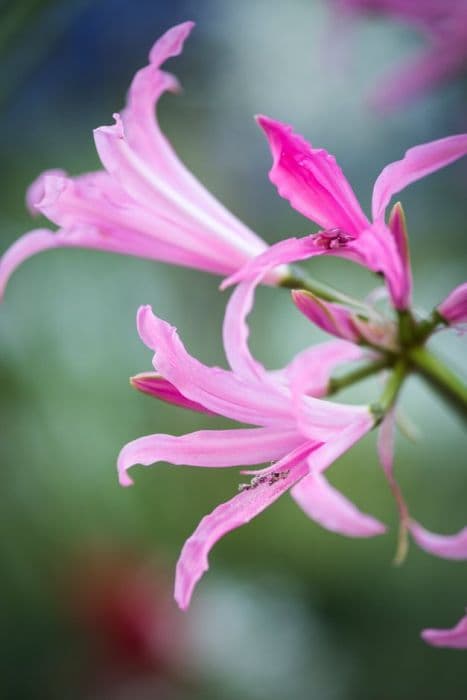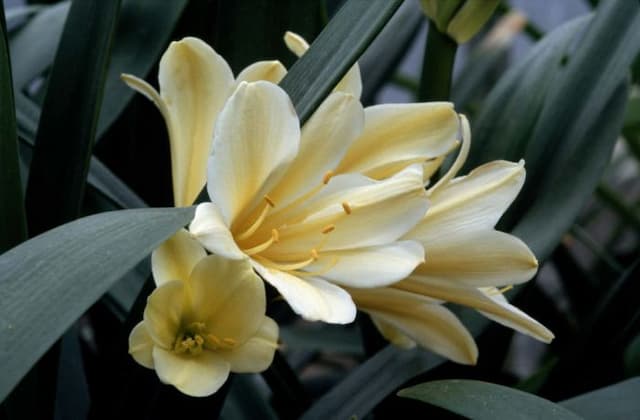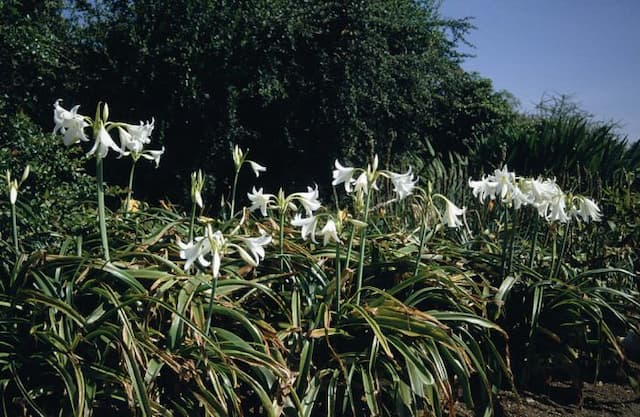Lesser Daffodil Narcissus minor (13)

ABOUT
Narcissus minor, commonly known as the lesser daffodil, features bright yellow flowers that are well-known symbols of spring. Each flower has a trumpet-shaped central corona surrounded by a ring of six petal-like tepals. These tepals are usually a lighter shade of yellow compared to the vivid corona, giving the bloom a two-tone effect. The plant's flowers tend to face upwards or slightly angled, ready to greet the warm sun. The leaves of the lesser daffodil are slender and strap-shaped, emanating from the base of the plant and forming a tidy clump of greenery. They have a sort of grass-like appearance but are distinctly sturdier and fleshier. The foliage can be described as a deep green, which complements the bright yellow of the blooms. In terms of the overall structure, the lesser daffodil bears its cheerful blossoms atop sturdy, erect stalks that arise from the base of the plant. These stalks are somewhat cylindrical and possess a smooth texture, contrasting subtly, with the linear ridges present on the leaves. As a springtime herald, the lesser daffodil also has a soft yet noticeable fragrance that can carry on the breeze, contributing to its overall charm. The blooms are solitary, ensuring that each individual flower gets its moment in the spotlight. This plant usually blooms in the early to mid-spring timeframe, adding to the procession of color that commonly marks this season.
About this plant
 Names
NamesFamily
Amaryllidaceae
Synonyms
Dwarf Daffodil, Dwarf Narcissus, Lesser Daffodil
Common names
Narcissus minimus, Narcissus pumilus.
 Toxicity
ToxicityTo humans
Narcissus minor, commonly known as Lesser Daffodil, is toxic to humans. All parts of the plant contain alkaloids such as lycorine and others that can cause poisoning if ingested. Symptoms of poisoning typically include nausea, vomiting, abdominal pain, and diarrhea. In severe cases, ingestion can lead to cardiac arrhythmias, low blood pressure, tremors, and convulsions. Handling the plant may also cause skin irritation or allergic reactions. It is important to avoid ingesting any part of the Lesser Daffodil and to exercise caution when handling the plant, especially if you have sensitive skin or are prone to allergies.
To pets
Narcissus minor, commonly known as Lesser Daffodil, is also toxic to pets. The plant contains compounds such as lycorine, which is poisonous to both cats and dogs if ingested. Symptoms of Lesser Daffodil poisoning in pets can include vomiting, excessive salivation, diarrhea, abdominal pain, and sometimes even cardiac arrhythmias or respiratory depression in severe cases. It is especially important to prevent pets from accessing and ingesting any part of the plant to avoid the risk of poisoning.
 Characteristics
CharacteristicsLife cycle
Perennials
Foliage type
Deciduous
Color of leaves
Green
Flower color
Yellow
Height
6 inches (15 cm)
Spread
6 inches (15 cm)
Plant type
Bulb
Hardiness zones
5
Native area
Mediterranean
Benefits
 General Benefits
General Benefits- Ornamental Value: Narcissus minor, commonly known as Dwarf Daffodil, adds aesthetic beauty to gardens with its bright yellow flowers in early spring.
- Easy to Grow: Dwarf Daffodils are hardy and can thrive in various climates and soil types, making them accessible for gardeners at all levels.
- Attracts Pollinators: Like many other flowering plants, Dwarf Daffodils attract bees, butterflies, and other pollinating insects, supporting biodiversity.
- Naturalizing: Dwarf Daffodil has the ability to spread and naturalize in an area over time, creating a carpet of color without much intervention.
- Symbolism: Dwarf Daffodils are often associated with rebirth and new beginnings, making them a meaningful addition to gardens and landscapes.
- Low Maintenance: Once established, Dwarf Daffodils require minimal upkeep aside from general watering and occasional fertilization.
- Deer Resistance: Narcissus plants are generally resistant to deer, which can help to preserve the garden's beauty in areas with deer populations.
 Medical Properties
Medical PropertiesThis plant is not used for medical purposes.
 Air-purifying Qualities
Air-purifying QualitiesThis plant is not specifically known for air purifying qualities.
 Other Uses
Other Uses- In perfumery, the Narcissus minor, commonly known as the wild daffodil, can be used for its fragrance. The oil from daffodils is sometimes used in high-end perfumes to provide a fresh and vibrant note.
- Dye production is another use for the wild daffodil. The petals contain compounds that can be processed into dyes for textiles.
- This plant can serve as a muse for artists and writers, often symbolizing rebirth and new beginnings in various works of art and literature.
- As a decoration, wild daffodils are often used in floral arrangements, specifically in spring bouquets to symbolize sunny, cheerful vistas after the winter months.
- In culinary uses, while not commonly eaten, the petals of wild daffodils have been used to create a delicate flavoring for certain specialty desserts, though great care must be taken because the bulbs are toxic.
- Gardening enthusiasts use wild daffodils as a way to naturalize wooded areas, where they can create the effect of a woodland carpet of flowers in early spring.
- Wild daffodil is used in fish poison in some traditional practices, where certain substances in the plant can act as a piscicide.
- The plant can also be used in horticultural therapy programs, as gardening activities involving daffodils can provide mental health benefits to participants.
- Some communities celebrate the bloom of wild daffodils with festivals or nature walks, using the flower to promote eco-tourism and appreciation for local ecology.
- In historical clothing, the wild daffodil has been used to create natural adornments or accessories, such as in the embellishment of hats or garments.
Interesting Facts
 Feng Shui
Feng ShuiThe Dwarf Daffodil is not used in Feng Shui practice.
 Zodiac Sign Compitability
Zodiac Sign CompitabilityThe Dwarf Daffodil is not used in astrology practice.
 Plant Symbolism
Plant Symbolism- Self-Love: Named after the Greek myth of Narcissus, these flowers often symbolize self-love and admiration, reminding us of the story where Narcissus fell in love with his own reflection.
- Renewal: As a herald of spring, the Narcissus minor represents new beginnings and the end of winter, embodying the theme of rebirth and renewal.
- Wealth: With their bright yellow flowers that resemble gold, these blooms are sometimes seen as omens of good fortune and prosperity.
- Vanity: Due to its connection to the Narcissus myth, the flower can also signify excessive self-absorption and vanity.
- Hope: The Narcissus being one of the first flowers to bloom in the year carries a message of hope and the persistence of life.
 Water
WaterDwarf daffodils should be watered deeply once a week, providing about 1 inch of water which equates to approximately 0.623 gallons per square foot. It's important to ensure that the soil is well-drained to avoid waterlogging as these plants are susceptible to rot. During the growing season, you might need to water more frequently if the weather is particularly dry or hot. Once the flowers have finished blooming and the leaves start to yellow, you can reduce watering as the plant goes dormant.
 Light
LightDwarf daffodils thrive in full sun to partial shade. The best spot for them would be an area that receives at least six hours of direct sunlight daily. If you plan to grow them indoors, a south-facing window is ideal to ensure they get enough natural light. Avoid placing them in deep shade as this can affect their ability to flower.
 Temperature
TemperatureDwarf daffodils prefer a temperate climate with cold winters. They can tolerate winter temperatures as low as 20 degrees Fahrenheit and generally require a chilling period to bloom successfully. The ideal temperature range for growing dwarf daffodils is between 50 and 70 degrees Fahrenheit during the active growing season. They can survive brief periods of temperatures slightly above this range but prolonged heat can be detrimental to their health.
 Pruning
PruningPruning dwarf daffodils is primarily limited to deadheading, which means removing spent flower heads. This should be done to maintain the plant's appearance and to prevent seed development, which can divert energy away from bulb growth. Leave the foliage in place until it has yellowed and died back naturally, usually about 6 weeks after flowering, as this period allows the bulbs to store energy for next season's blooms. Prune back the yellowed leaves in late spring or early summer.
 Cleaning
CleaningAs needed
 Soil
SoilDwarf Daffodil prefers well-draining soil with a mix of loam, peat, and sand, ensuring good drainage. The ideal soil pH should be slightly acidic to neutral, roughly between 6.0 and 7.0.
 Repotting
RepottingDwarf Daffodils should be repotted every 1-2 years, or after they finish blooming; this allows for division if they become overcrowded.
 Humidity & Misting
Humidity & MistingDwarf Daffodil thrives in average room humidity and does not require any special humidity conditions.
 Suitable locations
Suitable locationsIndoor
Place in bright, indirect light and cool temps.
Outdoor
Full sun to partial shade, shelter from strong winds.
Hardiness zone
4-9 USDA
 Life cycle
Life cycleNarcissus minor, commonly known as Lesser Wild Daffodil, begins its life cycle as a bulb which undergoes a period of dormancy, typically in the summer. As temperatures cool and autumn arrives, the bulb starts to develop roots and shoots. In late winter to early spring, shoots emerge from the soil growing into flowering stems that produce the characteristic yellow blooms. After flowering, the leaves photosynthesize to provide energy, which is stored in the bulb for the next growth cycle. Once the leaves die back in late spring or early summer, the plant re-enters dormancy, conserving energy in its bulb. The cycle resumes when the environmental conditions become favorable again in the following autumn.
 Propogation
PropogationPropogation time
Spring
The most popular method of propagation for the Narcissus minor, commonly known as "Lesser Wild Daffodil", is through division of the bulbs. The best time to propagate is in late summer to early fall, after the foliage has died back, but before the ground freezes. To propagate, carefully dig up the clump of bulbs and gently separate them. Each bulb can be replanted immediately at a depth of about 5 to 6 inches (12.7 to 15.24 centimeters) and a spacing of at least 6 inches (15.24 centimeters) apart to allow for growth. It’s important to keep the soil moist until the roots have established, but avoid waterlogging. This straightforward approach leverages the natural reproductive cycle of the daffodils, ensuring a continuation of bloom in the following seasons.









